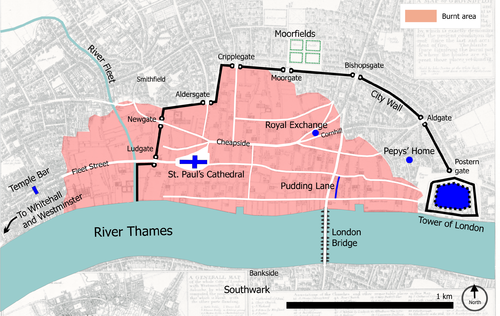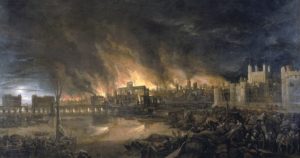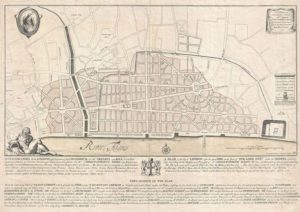GREAT FIRE OF LONDAN,1666
In the early morning hours, the Great Fire of London breaks out in the house of King Charles II’s baker on Pudding Lane near London Bridge. It soon spread to Thames Street, where warehouses filled with combustibles and a strong easterly wind transformed the blaze into an inferno. When the Great Fire finally was extinguished on September 6, more than four-fifths of London was destroyed. Miraculously, only 16 people were known to have died.
The Great Fire of London was a disaster waiting to happen. London of 1666 was a city of medieval houses made mostly of oak timber. Some of the poorer houses had walls covered with tar, which kept out the rain but made the structures more vulnerable to fire. Streets were narrow, houses were crowded together, and the firefighting methods of the day consisted of neighborhood bucket brigades armed with pails of water and primitive hand pumps. Citizens were instructed to check their homes for possible dangers, but there were many instances of carelessness.

So it was on the evening of September 1, 1666, when Thomas Farrinor, the king’s baker, failed to properly extinguish his oven. He went to bed, and sometime around midnight sparks from the smoldering embers ignited firewood lying beside the oven. Before long, his house was in flames. Farrinor managed to escape with his family and a servant out an upstairs window, but a bakery assistant died in the flames–the first victim.
Sparks from Farrinor’s bakery leapt across the street and set fire to straw and fodder in the stables of the Star Inn. From the Inn, the fire spread to Thames Street, where riverfront warehouses were packed full with flammable materials such as tallow for candles, lamp oil, spirits, and coal. These stores lit aflame or exploded, transforming the fire into an uncontrollable blaze. Bucket-bearing locals abandoned their futile efforts at firefighting and rushed home to evacuate their families and save their valuables.
The Great Fire of London: key facts
When did it start?
2 September 1666
When did it end?
5 September 1666
How much damage did it cause?
It is thought that the Great Fire of London destroyed up to four-fifths of the City of London, including most of the civic buildings, old St Paul’s Cathedral, 87 churches, and around 13,000 houses
How many people died?
“Though we do not know exactly how many people died as a result of the Great Fire of London, it was almost certainly more than commonly accepted figures,” says historian Rebecca Rideal .
London in the 1660s


Although the Great Fire was a catastrophe, it did cleanse the city. The overcrowded and disease ridden streets were destroyed and a new London emerged. A monument was erected in Pudding Lane on the spot where the fire began and can be seen today, where it is a reminder of those terrible days in September 1666.
Sir Christopher Wren was given the task of re-building London, and his masterpiece St. Paul’s Cathedral was started in 1675 and completed in 1711. In memory of Sir Christopher there is an inscription in the Cathedral, which reads, “Si Monumentum Requiris Circumspice”. – “If you seek his monument, look round”.



In the 1670s, a memorial column commemorating the Great Fire of London was erected near the source of the calamity. Known as the Memorial, it was probably designed by the architect Robert Hooke, though some sources credit Christopher Wren. The column stands 202 feet above the pavement and features sculpture and engravings that tell the story of the conflagration. Even though an official inquiry into the Great Fire concluded that “the hand of God, a great wind, and a very dry season” caused it, an inscription on the Memorial (removed in 1830) blamed the disaster on the “treachery and malice of the Popish faction.”
In 1986, London’s bakers finally apologized to the lord mayor for setting fire to the city. Members of the Worshipful Company of Bakers gathered on Pudding Lane and unveiled a plaque acknowledging that one of their own, Thomas Farrinor, was guilty of causing the Great Fire of 1666.

Nice ☝
ReplyDeleteNice blog
ReplyDeleteNice
ReplyDeleteGr8 👍👌
ReplyDeleteWow nice information .
ReplyDeleteThanks a man.
Great work man.
ReplyDeleteNice Information Well done Brother keep it up 🏁
ReplyDeleteGreat👍👏😊
ReplyDeleteOosm bro thanks for giving me this kind information
ReplyDelete